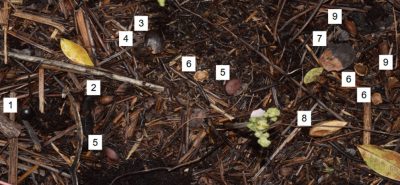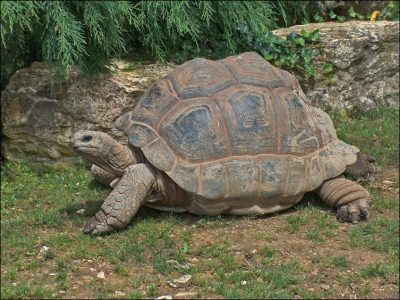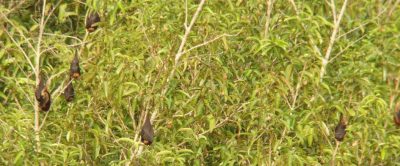What can be done to restore dispersal ?
PDF1. Restoring dispersal by sowing native trees

Based on these encouraging results, we decided to continue the experiments in tropical rainforests (Figure 1).
The success of direct sowing opens new perspectives for ecological restoration because it is easier to implement than traditional sapling plantations. The latter require very heavy logistics to be deployed on a large scale. As already shown elsewhere [2],direct sowing would allow sowing of remote high-stake areas such as the volcano caldera, which has the largest lowland protected area in the Mascarene Islands (see Figure 4, article How vertebrate extinctions are threatening tropical forests). It is even more important to maintain the most iconic rainforest tree species in this area to maintain attractive ecosystems in anticipation of the return of large frugivores.
2. Restoring dispersal by rewilding ecosystems
Direct sowing is not intended to be an effective substitute for large frugivores. Sowing can only be undertaken in limited spatial and temporal scales compared to the dispersal capabilities of large fauna. Nothing will ever replace large numbers of foraging frugivores with long ranges. However, while direct sowings could be easily deployed by conservationists, rewilding raises a number of social-ecological issues that make it more difficult to implement.
2.1. Re-introduction of terrestrial tortoises

Nevertheless, the recent reintroduction of land tortoises to the Ebony Forest reserve [4] on the mainland of Mauritius shows that a similar initiative could see the light of day in Reunion. While such a project should not be expected to have an ecosystem-wide impact (at first), a reserve with land tortoises could not only be an exciting experiment in ecological restoration, but also have an important educational purpose. It would help to the public aware of the essential role large vertebrates play in native tropical forests.
2.2 The case of the black flying fox

The return of the Mauritian flying fox to Reunion after a cyclone is a remarkable opportunity for forest ecosystems (Figure 3). Their still very modest population is currently growing and it is to be hoped that this bat, once highly valued for its meat, will not be victim of poachers. However, the return of fruit bats to Reunion sland raises two main concerns for some conservationists.
- The risk of new plant invasions in an already severely impacted island;
- The risk of conflict of interest with tree farmers.
The risk of seeing the bats dispersing exotic plants exists. However, these potential negative effects will certainly be counterbalanced by the restoration of mutualistic pollination and dispersal interactions that have been extinct for centuries [5].In particular, their ability to disperse seeds over long distances will restore gene flow for many native species that have been locked in their forested areas for over 150 years. To see the positive impact of Mauritian flying fox, one need only observe the remarkable regeneration of most native plants at Brise Fer despite the existence of many invasive exotic plants on the landscape scale in this massif (see Section 3.2 How vertebrate extinctions threaten tropical forests).
On Reunion Island, lowland native forests rich in large fleshy-fruited trees are often highly fragmented and in close proximity to cultivated areas. With the growth of the fruit bat population, the potential conflict of interest with arborists should be anticipated. The challenge is great as shown by the situation in Mauritius where this species, which plays a key role in the native forests, has been decimated in the last decade. Therefore, local conservationists should ensure that the conditions for the acceptance of this emblematic species are created and include an important socio-ecological component in future research. This work can only facilitate other reintroduction projects, such as the one concerning the Mascarene parakeet, which is being actively considered by several key conservation stakeholders in Reunion Island.
Notes
Cover image. Copy of one of the images in figure 7 of the main article.
[1] Albert S. (2020) Rupture des interactions mutualistes plantes à fruits charnus-vertébrés frugivores, et conséquences sur la régénération des forêts tropicales dans les Mascareignes, Doctoral dissertation, Université de La Réunion. [On line]. Available at: https://tel.archives-ouvertes.fr/tel-03126708
[2] Shaw N. et al. (2020) Seed use in the field: Delivering seeds for restoration success, Restor. Ecol., 28, S3, S276-S285, https://doi.org/10.1111/rec.13210.
[3] Griffiths C. J., Hansen D. M., Jones C. G., Zuël N. & Harris S. (2011) Resurrecting extinct interactions with extant substitutes, Curr. Biol. 21(9), 762-765 Available at: http://www.sciencedirect.com/science/article/pii/S0960982211003460
[4] Ebony forest reserve turtles: https://www.ebonyforest.com/facilities/tortoises/
[5] Florens F. B. V. et al. (2017) Disproportionately large ecological role of a recently mass-cultivated flying fox in native forests of an oceanic island, J. Nat. Conserv. 40, 85-93, https://doi.org/10.1016/j.jnc.2017.10.002




